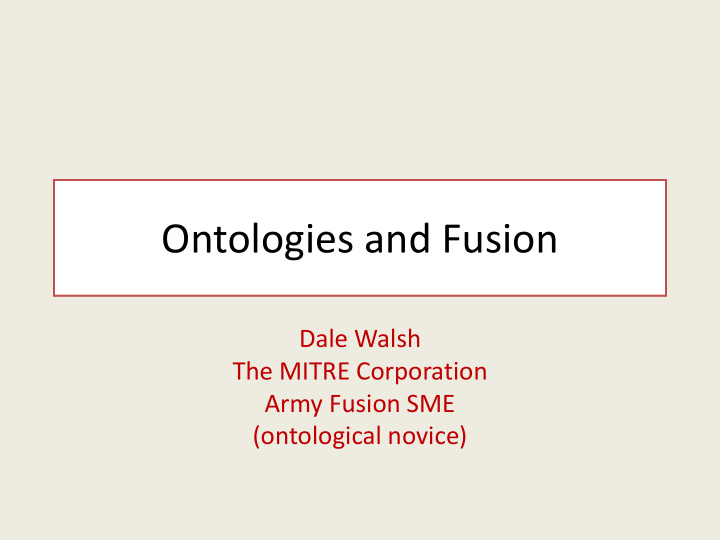



Ontologies and Fusion Dale Walsh The MITRE Corporation Army Fusion SME (ontological novice)
“Fusion” • JCS Pub 1-02 The process of examining all sources of intelligence and information to derive a complete assessment of an activity. • Textbook A process dealing with the association, correlation, and combination of data and information from single and multiple sources to achieve refined position and identity estimates, and complete and timely assessments of situations and threats, and their significance. The process is characterized by continuous refinements of its estimates and assessments, and the evaluation of the need for additional sources, or modification of the process itself, to achieve improved results. (Llinas/Hall) • Army’s “Usable” Definition A series of processes performed to transform observational data from all sources into more detailed and refined information, knowledge, and understanding. These processes, by their very nature, will involve both automated processes and human cognition. Also included as part of fusion are the databases, human interfaces and information portrayal, and the control and feedback of the fusion process. (Walsh/Jones)
Knowledge Discovery and the Cognitive Hierarchy C O R P U S
The “History” of All Source Intelligence • Human Intelligence – circa 4000 BC (Deut 1:22) • Open Source Intelligence – 1439 AD (Gutenberg) • Imagery Intelligence – 1860 AD (King/Black) • Signals Intelligence – 1880 AD (Marconi/Orsted) • Intel Systems with databases – 1985 AD (ASAS) – Technology always complicates things…
Unstructured vs. Structured vs. Unstructured “Gen McDowell, the Stone Bridge is jammed with our retreating troops plus the civilians who came to watch the battle!” MSGID/TACREP/33 MKR BN// GNDOP/211745Z/1/US/BRIDGE/STONE BRIDGE/-/38.81N77.52W// OPSUP/OPSTAT:NOOP// RMKS/RETREATING TROOPS HAVE CLOGGED THE BRIDGE// #stupidtraffic: Can’t get out of Bull Run… Union troops jammed up the bridge!
Why “structured” was easy (USMTF, 1979-2010, R.I.P.) • The cognition part was done by the preparer – Selected a format – Selected the codes to use – Set it all in a processable framework • Human “reading” worked okay • Machine reading worked very well – Parse, fuse, update the database with the latest and greatest
Why “unstructured” is “hard” • The preparer just writes, using whatever language, jargon, etc. he/she chooses • Some military reporting is semi-structured (CIDNE) • The cognition must be applied (re-applied?) on the receiver’s end • De-jargonization • Disambiguation • Standardization of terminology • Context and actual meaning
Reality • “Event” type – Structured: 792 possible values, forming a taxonomy • Border Raid, Nuclear Accident, Tribal Riot, Ambush – Unstructured: thousands of “actions” in WordNet or FrameNet • Acquire, cause, deliver, departure, mitzvah, propulsion • “Relationship” type • “Person role” What the existing classic ontological approaches have in structure, they seem to lack in operational richness…
Can we come together? (A notion…) • Our fusion goal is to create a graph of the entities and events that exist in the world of interest (people, places, things, happenings) • Appears we can use ontological approaches to build a graph of the words we receive • So then, could we create a graph mapping between these two?? • Max Planck Institute’s AIDA
Can the approach used by AIDA help? What else might?
Recommend
More recommend